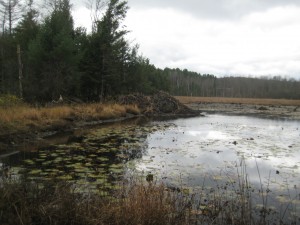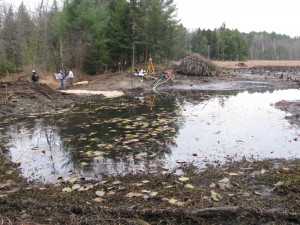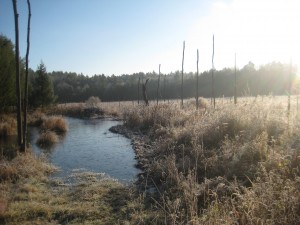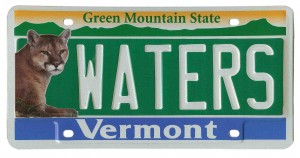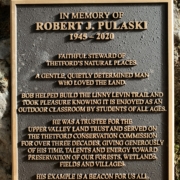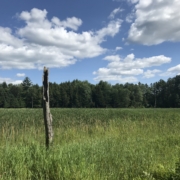Zebedee Wetland – dam removal is complete!
As fall began its progression to winter, the Zebedee Headwaters property continued its transition to a more naturally functioning wetland ecosystem. The Upper Valley Land Trust, as owner of the property and recipient of a Watershed Grant from the State of Vermont, is committed to stewarding this property as a natural area for people to visit, learn, and enjoy.
With this stewardship commitment in mind, UVLT has worked to remove an old earthen dam and return the wetland to a more natural condition. UVLT contracted with a qualified engineer and consulted with Vermont’s Wetlands Bureau, to restore the Zebedee wetland by breaching the earthen dam that has impounded the waters of Zebedee Brook for decades.
This work has gone as follows:
- UVLT obtained permits from VT Agency of Natural Resources to remove the dam;
- Engineering and surveying – studies by professionals resulted in plans for a breach of the dam to recreate the natural channel outlet of the wetland, and carefully control any potential erosion;
- Water lowering and dam breach – Water levels were drawn down, and, when conditions permitted, UVLT’s local contractor performed the dam breach according to the engineer’s plans;
- Erosion control – (1) the contractor stabilized and seeded the site where material from the dam was deposited and the wide sloped opening that reestablished the channel for Zebedee Brook, and (2) On the recommendation of the VT Wetlands Bureau, UVLT seeded the exposed soils within the wetland that resulted from the lower water levels with native wetland seed from Vermont Wetland Plant Supply.
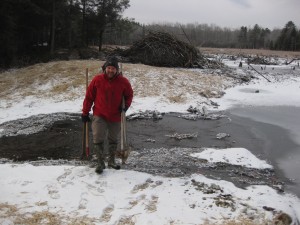
Jason Berard, UVLT Stewardship Coordinator, cleans up after broadcasting the native wetland seeds at Zebedee
With this dam breach – now complete! – Zebedee Brook will again flow along its natural course through this beautiful area, on its way to the Connecticut River.
Of course, the beaver colony currently residing in these headwater stretches may have another plan in mind. While much of the woody food supply immediately surrounding this portion of the Zebedee wetland has already been consumed, the activity just upstream (including a growing beaver dam close to the gate on UVLT’s property) is busier than ever.
What happens if the beaver just rebuild the dam? In short, if the beaver decide that re-creating the pond is beneficial to them, they will attempt it. UVLT staff will continue to monitor the property and we hope to find no need to intervene. We will join you in marveling at the dedication and craftsmanship of these impressive rodents.
A beaver dammed wetland is more dynamic than a system that includes a manmade dam, such as the one that UVLT had breached at Zebedee Headwaters. If the beaver reconstruct their own dam in this spot, the pond will fill up, and the beaver will maintain the dam with sticks and mud while utilizing the nearby landscape for food and building materials. In time, however, the beaver will run out of their preferred food sources, and move on. As these dams break down without steady maintenance from the beaver, the waterway will reopen, and the wetland communities will shift in response. One day, after the food source has reestablished in their absence, the beaver may return. This dynamic system is one that has helped create so much of the ecological mosaic of our region, and UVLT is pleased to know that Zebedee Headwaters is becoming a natural place once again.
The dam removal and wetland restoration work at Zebedee Headwaters was funded in part through a Vermont Watershed Grant made possible through the Conservation License Plate Program:

